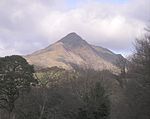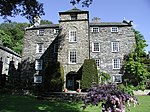Croesor Tramway
2 ft gauge railways in WalesHorse-drawn railwaysIndustrial railways in WalesRailway inclines in WalesRailway lines closed in 1948 ... and 5 more
Railway lines opened in 1864Railway lines opened in 2010Slate industry in WalesUse British English from March 2018Welsh Highland Railway

The Croesor Tramway was a Welsh, 2 ft (610 mm) narrow gauge railway line built to carry slate from the Croesor slate mines to Porthmadog. It was built in 1864 without an Act of Parliament and was operated using horse power. The tramway was absorbed into the Croesor and Port Madoc Railway in 1865 and later became the Portmadoc, Croesor and Beddgelert Tram Railway in 1879. Part of its route, from Croesor Junction to Porthmadog, was taken over by the Welsh Highland Railway in 1922, and upgraded to allow the operation of steam locomotives. The remainder of the line continued as a horse-drawn tramway, and operated as such until the mid-1940s.
Excerpt from the Wikipedia article Croesor Tramway (License: CC BY-SA 3.0, Authors, Images).Croesor Tramway
Geographical coordinates (GPS) Address Nearby Places Show on map
Geographical coordinates (GPS)
| Latitude | Longitude |
|---|---|
| N 52.981944444444 ° | E -4.0402777777778 ° |
Address
LL48 6SR , Llanfrothen
Wales, United Kingdom
Open on Google Maps









